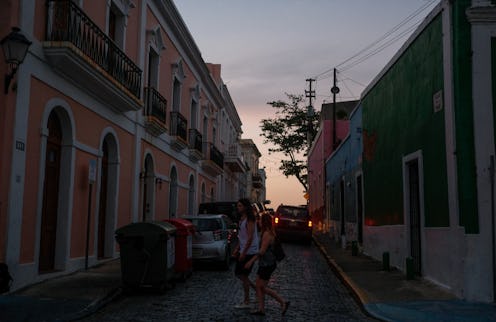News
It Took 11 Months, But Nearly All Of Puerto Rico Finally Has Power Again

Nearly a year after Hurricane Maria decimated its electrical grids, Puerto Rico has finally restored power to the vast majority of customers on the island. The Puerto Rico Electric Power Authority announced on Tuesday that all but 25 of the residents who lost power during the storm now have it again.
That's a significant milestone. When Maria hit in September 2017, all 3.3 million of Puerto Rico's residents were plunged into complete darkness as the storm knocked out the entire island's electrical grids. Since then, the U.S. territory has struggled to recover, and PREPA has blown past its self-imposed goals for restoring power to the island: The state-owned agency said in March that it was aiming to have power restored to the entire island by May — but as of June, thousands of residents were still without power.
More disturbing was the storm's human toll. Authorities on the island initially estimated that only 64 people died as a result of Maria; this number was immediately met with skepticism, with San Juan Mayor Carmen Yulín Cruz telling CNN that she believed the death toll could be as high as 500. In June, Harvard researchers who polled households on the island determined that in fact, as many as 4,645 people were killed when the storm swept the island.
As a result of the massive infrastractural damage that Maria brought to the island, there was a mass exodus of Puerto Ricans to the U.S. mainland after the storm. Although there's no precise data on how many people left the island in Maria's wake, a study by the City University of New York's Center for Puerto Rican Studies concluded that around 135,592 Puerto Ricans have settled in the continental United States since the hurricane hit. They've moved to every U.S. state except for Hawaii, according to that study, with over 80 percent settling in one of six states: Florida, Connecticut, Massachusetts, New York, New Jersey and Pennsylvania.
"This is the greatest migration ever from Puerto Rico since records have been taken," Jorge Duany, a professor of anthropology at Florida International University, told CNN.
President Trump was widely criticized for his handling of the Puerto Rico crisis. In the immediate aftermath of the storm, he tweeted that the territory was in "deep trouble" not because of the storm, but because of the "massive debt" and "billions of dollars owed to Wall Street and the banks which, sadly, must be dealt with." He then personally attacked Cruz, accusing her of exhibiting "poor leadership" and claiming that Puerto Rican relief workers "want everything to be done for them."
Although the GOP-controlled Congress did authorize $4.9 billion in relief money for Puerto Rico, it did so in the form of a loan, not a grant. This meant that the island would eventually have to pay the money back to the federal government — setting it apart from places like California and Texas, which were given grant money in that same piece of legislation to deal with their respective natural disasters.
In January, however, the Trump administration announced that Puerto Rico wouldn't be receiving that loan at all, because the territory already had a cash balance of $1.7 billion. An analysis by the catastrophe-modeling firm AIR Worldwide estimated that Puerto Rico suffered over $70 billion in damages as a result of Maria.